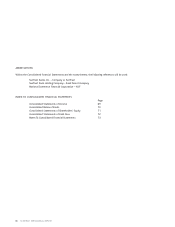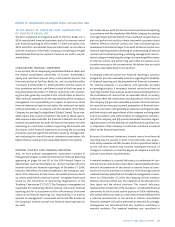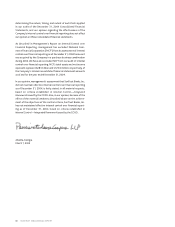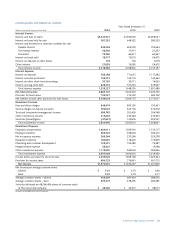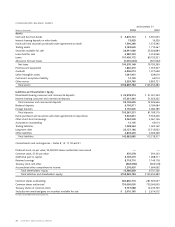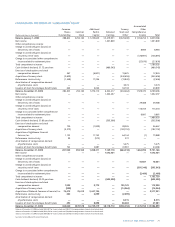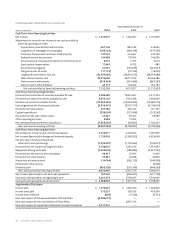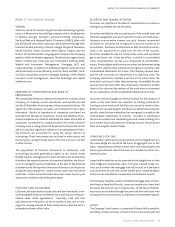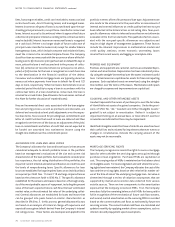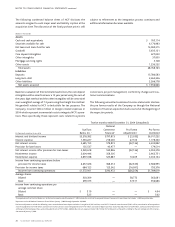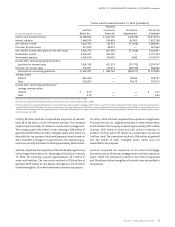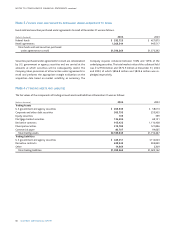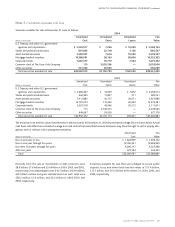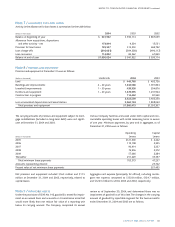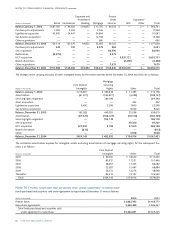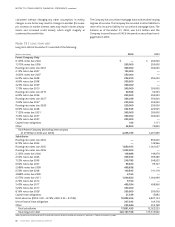SunTrust 2004 Annual Report Download - page 78
Download and view the complete annual report
Please find page 78 of the 2004 SunTrust annual report below. You can navigate through the pages in the report by either clicking on the pages listed below, or by using the keyword search tool below to find specific information within the annual report.
76 SUNTRUST 2004 ANNUAL REPORT
NOTES TO CONSOLIDATED FINANCIAL STATEMENTS continued
stock-based employee compensation plan are included in Note 16
to the Consolidated Financial Statements.
ACCOUNTING POLICIES ADOPTED
In December 2003, the FASB issued Interpretation (FIN) No. 46
(Revised),“Consolidation of Variable Interest Entities, an Interpre-
tation of ARB No. 51” (FIN 46(R)). FIN 46(R) addresses consolida-
tion by business enterprises of VIEs and revises FIN 46 to provide
different implementation dates based on the types of entities sub-
ject to the Interpretation and based on whether a company had
adopted FIN 46. The Interpretation is based on the concept that an
enterprise controlling another entity through interests other than
voting interests should consolidate the controlled entity. An enter-
prise that holds a majority of the variable interests is considered the
primary beneficiary and would consolidate the VIE. The Company
adopted FIN 46(R) as of March 31, 2004, and the adoption did not
have a material impact on the Company’s financial position or
results of operations. The required disclosures related to the
Company’s significant variable interests in VIEs are included in Note
17 to the Consolidated Financial Statements.
In March 2004, the Securities Exchange Commission (SEC) Staff
issued Staff Accounting Bulletin (SAB) No. 105, “Application of
Accounting Principles to Loan Commitments,” which addresses the
accounting treatment for loan commitments accounted for as
derivative instruments. Interest rate lock commitments (IRLCs) rep-
resent commitments to extend credit at specified interest rates. In
the normal course of business, the Company enters into derivatives,
consisting primarily of mortgage-backed security (MBS) forward
sale contracts, to offset the change in value of its IRLCs related to
residential mortgage loans that are intended to be held for sale.
Estimates of the degree to which IRLCs are expected to result in
closed residential mortgage loans are used to determine appropri-
ate levels of MBS forward sale contracts.
The SAB references SFAS No. 149,“Amendment of Statement 133
on Derivative Instruments and Hedging Activities,” as the primary
guidance for IRLC recognition, where IRLCs are classified as deriva-
tive financial instruments.Additionally, Emerging Issues Task Force
(EITF) Issue No. 02-3, “Issues Involved in Accounting for Derivative
Contracts Held for Trading Purposes and Contracts Involved in
Energy Trading and Risk Management Activities,” provides guidance
that the absence of an active exchange or market for derivative
financial instruments renders its recorded value at inception as zero,
with subsequent fair values recorded as assets or liabilities.The esti-
mated fair value of IRLCs is derived from current MBS prices, and no
fair value is recorded at inception with subsequent changes in value
recorded in earnings. Accordingly, the Company accounts for IRLCs
associated with mortgages to be held for sale as freestanding
derivative financial instruments in accordance with SFAS No.
133, as amended by SFAS No. 149, and EITF Issue No. 02-3.
However, originated IRLCs that are intended for investment fall
under SFAS No. 149 paragraph 7(e) and are not treated as derivative
financial instruments.
SAB No. 105 permits the recognition of servicing assets only when
the servicing asset has been contractually separated from the
underlying loan by sale or securitization of the loan where servicing
is retained.Additionally, the SAB prohibits entities from recording
internally-developed intangible assets as part of the loan com-
mitment derivative. SAB No. 105 is effective for mortgage loan
commitments that are accounted for as derivatives and are entered
into after March 31, 2004.The adoption of SAB No. 105 did not have
a material impact on the Company’s financial position or results
of operations.
In May 2004, the FASB issued FASB Staff Position (FSP) No. 106-2,
“Accounting and Disclosure Requirements Related to the Medicare
Prescription Drug, Improvement and Modernization Act of 2003,”
which provides guidance on how companies should account for the
impact of the Medicare Prescription Drug, Improvement and
Modernization Act of 2003 (the “Act”) on its post retirement health
care plans.To encourage employers to retain or provide post retire-
ment drug benefits, beginning in 2006 the federal government will
provide non-taxable subsidy payments to employers that sponsor
prescription drug benefits to retirees that are “actuarially equiva-
lent” to the Medicare benefit. The Company has determined,
through independent third party consultation, that its post retire-
ment health care plans’ prescription drug benefits are actuarially
equivalent to Medicare Part D benefits to be provided under the Act.
The Company adopted the provisions of the FSP effective July 1,
2004, based on a remeasurement of the accumulated post
retirement benefit obligation (“APBO”) as of January 1, 2004.The
adoption of the FSP did not have a material impact on the
Company’s financial position or results of operations.The required
disclosures related to the Company’s APBO and net periodic post
retirement benefit cost are included in Note 16 to the Consolidated
Financial Statements.
RECENTLY ISSUED ACCOUNTING PRONOUNCEMENTS
In December 2003, the American Institute of Certified Public
Accountants (AICPA) issued Statement of Position (SOP) 03-3,
“Accounting for Loans or Certain Debt Securities Acquired in a
Transfer.” The SOP addresses the accounting for differences
between contractual cash flows and cash flows expected to be col-
lected from an investor’s initial investment in loans or debt securi-
ties acquired in a transfer if those differences relate to a
deterioration of credit quality. The SOP also prohibits companies
from “carrying over” or creating a valuation allowance in the initial
accounting for loans acquired that meet the scope criteria of the
SOP.The SOP is effective for loans acquired in fiscal years beginning
after December 15, 2004.The adoption of this SOP is not expected
to have a material impact on the Company’s financial position or
results of operations.
In March 2004, the EITF reached a consensus on EITF Issue No. 03-1,
“The Meaning of Other-Than-Temporary Impairment and Its
Application to Certain Investments.”The Issue provides guidance for
evaluating whether several types of investments, including debt
securities classified as held to maturity and available for sale under
SFAS 115, “Accounting for Certain Investments in Debt and Equity


